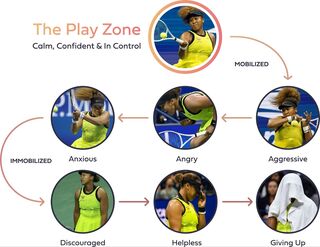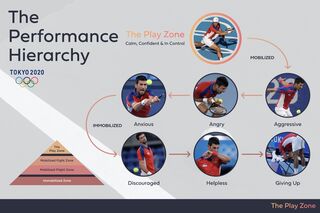By Michael Allison, performance and polyvagal coach
“He will lie, cheat, steal and do whatever it takes to win!” No, this isn’t a quote about a former president; this is a text message I received from a parent of a 14-year-old junior tennis player. This parent was upset that his boy gave up and didn’t fight back against the cheater in the match.
“I’m not sure if he’s got the killer instinct. He doesn’t get mad and want to destroy the kid when he’s cheating. I wonder if this can be learned, or maybe he’s going to be a beautiful player who isn’t a great competitor.”
I coach athletes, performers of all kinds, and coaches (parents too) on a unique application of polyvagal theory to regain control of our physiology for optimizing our resilience and performance, on and off the court. In this tennis match involving two players and a parent coach, we have three fascinatingly different subconscious, adaptive physiological reactions driving distinctly unique behaviors, narratives, and personal experiences.
The boy who cheats to win is stealing points because he’s afraid to lose and is searching for a sense of safety and control in his body. With limited internal resources, he’s developed his go-to strategy of "hooking" (calling in balls out) that often serves him well in junior tournaments without referees. However, it’s not a great recipe for making friends and establishing a solid reputation; nor is it sustainable long term.
The boy who doesn’t cheat to win experiences a dishonest call by his opponent as a cascade of bodily feelings that overwhelm his resilience. Instead of fighting back, he quickly looks for a place to hide, loses energy, gives up, and wants to get off the court altogether.
The dad who wants his kid to develop a killer instinct is amping up and waging war against a teenage boy in order to stop the pain and suffering he feels inside his body when he helplessly watches his vulnerable son struggling with adversity, being taken advantage of, and being unwilling to attack, fight back, and do whatever it takes to win.
Despite each of their different responses to the same situation, they all share a common theme below the surface of what we see, hear, and interpret. They don’t feel safe. And they aren’t alone, as we see the same predictable pattern of behaviors, emotions, and reactions displayed in dramatic fashion on the professional stage as well.
Beneath their emotions, behaviors, and reactions is a body sensing danger, being under threat, or feeling overwhelmed with no way out. Although this might sound soft, this is actually hard science based on polyvagal theory, a neurophysiological framework developed by Stephen W. Porges Ph.D., that describes how feeling safe or unsafe in our body biases what we think, feel and do.

What looks to be intentional—poor choices or character flaws—actually are not planned decisions made by our thinking brain. These are adaptive bodily reactions triggered by the autonomic nervous system and follow a sequence of survival responses we all share.
At all times, in every environment, interaction, and situation, on and off the court, we either feel safe or unsafe. This feeling emerges in our body beneath conscious control and impacts every aspect of our health, resilience to adversity, illness, disease, and overall well-being. We are always scanning and evaluating the current conditions as safe or unsafe, whether we are aware of it or not, and this influences how we experience the world, interact with others, and feel about ourselves from the inside out.
This is happening in every aspect of our lives—sports, business, schools, relationships, politics, etc. The cultures we play in, work in, learn in and live in are competitive, evaluative, unpredictable, and constantly changing. Because of all of this, we don’t always feel safe. Beyond the removal of threat, in order to feel safe we must receive sufficient cues of safety, stability, and connection from the world around us, within our own body, and in our relationships with others. Unfortunately, this isn’t how life treats most of us, and we can get locked in a mobilized threat response and adaptively retune our body to be on guard, hypervigilant, aggressive, anxious, or restless. When the threat persists, and we fail to escape or overcome the challenge, we eventually deplete our metabolic resources and overwhelm our capacity to keep going. As a last-ditch effort to survive, we will reflexively conserve what’s left, hunker down, numb the pain, withdraw, collapse or shut down altogether.

When we look at the world through a polyvagal lens, we see the predictable patterns of behaviors playing out all around us, the sequence of survival responses in ourselves and others, and bodies that either feel safe or unsafe. When we meet the body where it is (ours and theirs), we stop blaming, shaming, and criticizing. We recognize what’s beneath the reactions, and we start looking for ways we can help ourselves and each other to feel safe in our body, alone and together. This is our shared journey from our first breath to our last.
We can see “safety” playing out in the meteoric rise of a 19-year-old Spanish tennis player named Carlos Alcaraz. Beneath his blistering forehand, crafty drop shots, and lightning speed around the court is a body that feels absolutely safe, comfortable, and in control.
We can hear “safety” in the story of an everyday Ukrainian who stayed in her country despite total chaos and uncertainty because she felt a sense of unity and warmth from the people around her and wanted to help out in any way that she could.
We can feel “safety” in our own experience when we exchange a fist bump to show that we are in this together, receive an appreciative smile from someone who needed our help or feel our dog’s paw gently curl around our neck when we pet his belly.
We know what safety is. We know it when we see it, hear it, and feel it in our own body and when it’s being expressed from the body of another. It’s essential. It’s contagious. Even when under constant evaluation, facing a competitive culture of fighters, or navigating a world of uncertainty and challenge—we can help ourselves and each other to feel safe in our bodies. We need to, and it’s time.
"behavior" - Google News
May 31, 2022 at 10:13AM
https://ift.tt/dapf7vW
How Our Feelings of Safety Guide Our Behavior - Psychology Today
"behavior" - Google News
https://ift.tt/soywlq9
Bagikan Berita Ini














0 Response to "How Our Feelings of Safety Guide Our Behavior - Psychology Today"
Post a Comment